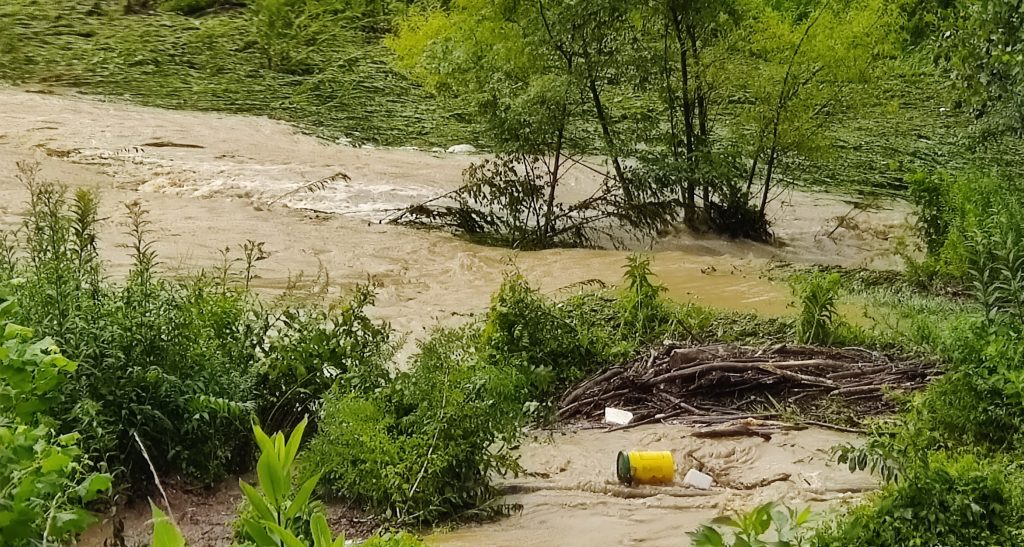Logging operations in national forests can have a significant detrimental impact on the ecological health of these vital forest systems and the surrounding communities.
Loss of Mature Forest
The Forest Service’s project plan says most of the Jellico Mountain area is trending towards mature forest. Older forests are vital for carbon sequestration and biodiversity.
Invasive Species
A logging operation can involve dozens of vehicles making hundreds of trips over weeks or years to a remote area. Vehicles, workers, wildlife, and birds can transport seeds of non-native plants into logged forests, where the reduction of canopy and newly disturbed soils allow invasive species to take root and outcompete native species.
Invasive species that represent a “severe threat” in Kentucky include Tree-of-Heaven, Autumn Olive, Japanese Honeysuckle, Kudzu, Japanese Knotweed, Multiflora Rose, Water Hemlock, and Johnson Grass.
Noise
Logging operations are noisy. For example, chainsaws operate at 90-110 decibels. One in three loggers report hearing loss. A neighbor can hear a chainsaw in a windy forest 460 feet away, or 830 feet away in a quiet forest. Vehicle engines rumble through these hollers, and tree falls sound like thunder.
Traffic
With logging comes trucks, noise, exhaust, and traffic, often along narrow, curvy mountain roads.
Runoff & Erosion
In a mature forest, surface runoff and soil erosion are generally low because of the natural forest litter layered on the ground. Logged areas are far more likely to experience erosion, landslides, and sediment deposited in streams. The increased runoff quadruples the erosive force to carry up to 1000X more mass of sediment. Erosion reduces forest productivity by decreasing available soil, water, and nutrients.
Landslides
Studies show that logging on a steep, concave (bowl-shaped) slope increases the likelihood of shallow landslides, mainly because of the loss of tree-root strength. Roots bind soil particles and reinforce a slope. A mature forest canopy blocks heavy rain and wind from eroding the surface. Heavy logging machinery disturbs and compacts topsoil, lowering its ability to absorb water.
Flooding
Mature forests hold and use more water than young forests, farms, and meadows. Leaves on trees catch rainwater, causing some to evaporate, while the rest drips to the ground and is less likely to erode the soil. Tree roots absorb water, drying the soil so it can hold even more rainwater. Logging increases the magnitude and frequency of floods.
The Forest Service plans to log nearly all the mountaintops above Jackson Creek. How will the logging affect our creeks, ponds, and property? We walked across this normally placid creek just hours before the devastating flood in July 2022:

The British Columbia government paid $300,000 to settle a lawsuit by a Canadian couple whose property severely flooded after the government logged a third of the surrounding forest.
Altered Stream Flow
Roads, ditches, and newly created gullies can dramatically alter the paths of water flow across the landscape, which in turn greatly affects the health of aquatic organisms. Increased sediments, temperature, and pH levels can decrease survival rates of many fish, amphibian, and invertebrate species. Logging can degrade spawning areas, reduce pool refuge habitat, and impede feeding visibility. Loss of water species negatively affects mammals, birds, and bats.
Disturbed & Compacted Soil
Logging machinery, vehicles, and operations disturb from 23% to over 70% of the soil in a logged area, compacting some areas while generating erosion and sedimentation in others. Soil compaction can last for decades and restricts root growth; reduces nutrients, oxygen, and water available to vegetation; and has a significant detrimental effect on microorganisms found in the soil. Disturbed soils promote the establishment of invasive non-native plant species.
Sedimentation
The concentrated nature of runoff from forest roads and snig-tracks, particularly on side slopes, makes it difficult to control sediments and deposit them in the forest before they reach streams. High concentrations of sediments can increase the transport of heavy metals, organics, and pathogens, which can harm aquatic ecosystems and contaminate drinking water sources in downstream communities. Sedimentation is most pronounced in the first few years following logging, but watersheds do not return to pre-harvest sediment levels for two decades.
Reduction of Biodiversity
USFS logging operations often follow an even-aged management protocol. This reduces biodiversity in a forest by encouraging a plantation-like prescription to logged landscapes. A 2016 study showed that 50% intensity logging, which removes half of all mature trees in a forest, retained biodiversity levels for most plant and animal species except birds and mycorrhizal fungi, whose biodiversity decreased. (Mycorrhizal fungi improve the growth, nutrition, water absorption, and disease resistance of their host plants.) Whereas 100% logging, which removes all mature trees, greatly decreased biodiversity across nearly all species.
Tree Disease
Logging increases the likelihood of introducing and spreading lethal tree diseases. Stumps left behind after logging experience much higher infection rates than living trees. Logging debris left behind also invites disease and insect pests. Trees stressed by logging and disease are more susceptible to attack by bark beetles and other insects.
Habitat Fragmentation
Logging can cause habitat fragmentation by changing large areas of forest from one habitat type to another. Species that thrive in mature forests will have to migrate to other areas if possible, otherwise they’ll have to adjust to conditions no longer compatible with their natural habitat needs. Many plants and animals will simply perish under the new conditions.
Climate Change
Logging mature and old forests contributes to global warming by removing significant sources of sequestered carbon and creating net carbon emissions for decades. Clear cutting also alters the local microclimate, resulting in hotter and drier conditions, which also increases fire hazard.